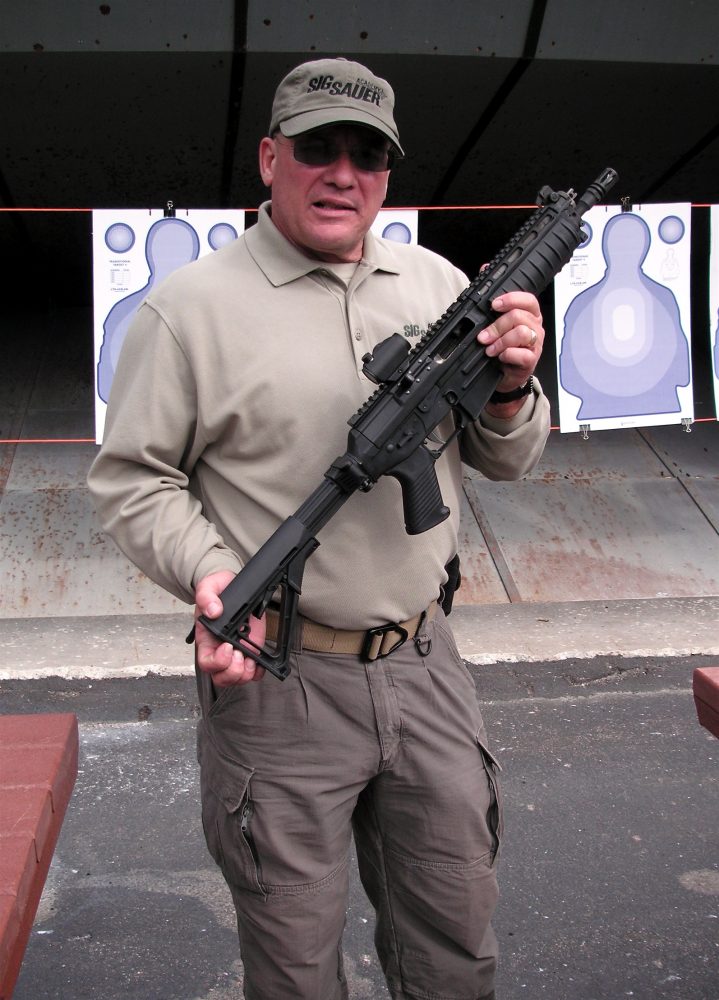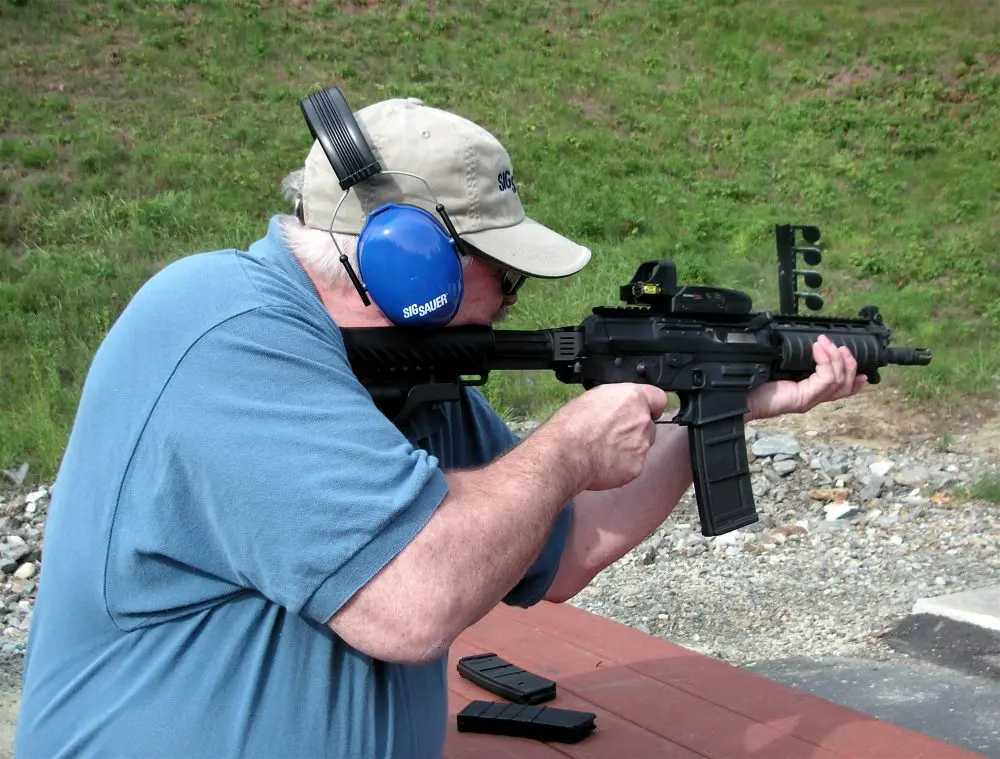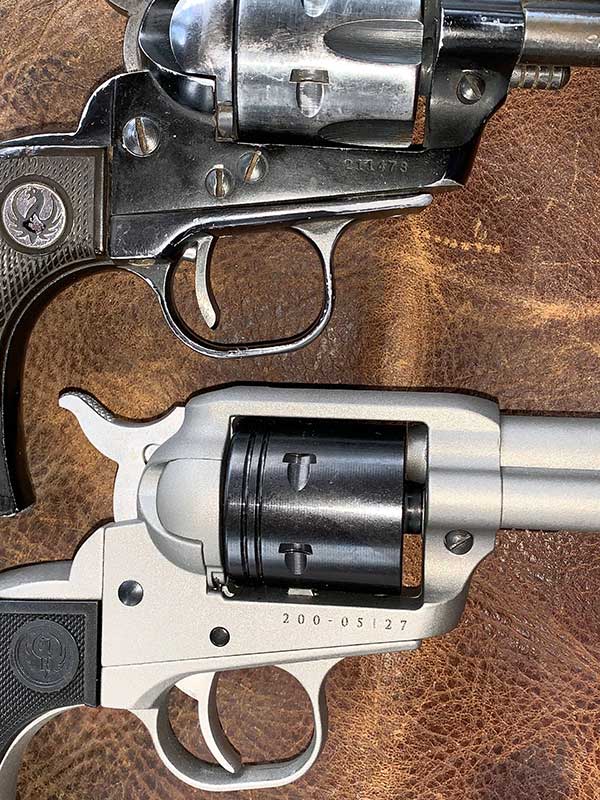Since I’ve been using a SIG 550 for many years, I have to admit that I was a bit skeptical about whether the SIG 556 could measure up to the legendary 550.
I started using a 556 SWAT model a few months ago and actually have been quite impressed. It kept many features of the 550, such as the full-length gas piston operating rod system, the two-position adjustable gas valve, the rotating bolt, and the 550-type pistol grip and cocking handle. The 556 has a flat top upper; hence, SIG only incorporates rudimentary flip-up sights as opposed to the rear sight and post front on the 550.
Thompson shooting 556 Short SF on full auto. It’s a very controllable carbine.
The 550 takes SIG proprietary magazines, while the 556 is designed to take M16 magazines. At first, I expected this to be one of the features I would find a negative, since I like to ability to couple magazines. However, the SIG polymer magazines designed for the 556 may be coupled as well. I like this feature because it means I can have two full mags carried ready on the carbine.

Let me digress for a minute on the coupled magazines. Since I initially learned the mag change drill on a SIG 550 carried across the chest and with the 550 paddle mag release, I learned to carry the rifle with the second magazine to the right of the receiver and to change by hitting the mag release and pulling the empty magazine down and to the left, then thrusting the loaded magazine home.
I continued this drill with the 556, but George Harris, director of the SIG Sauer Academy, showed me that with the 556, it makes more sense to carry the second mag to the left of the receiver, hit the AR-15-type mag release button with the right hand, pull the empty magazine down and push to the right, then thrust the full magazine home, followed by hitting the bolt release button with the support hand. He’s right, and I have begun practicing this drill with my 556.
I’ve now put about 500 rounds through my 556 SWAT and have found it quite accurate and utterly reliable. Trigger pull is very good and I have been able to shoot groups with it at 200 yards in the MOA (Minute of Angle) range. Basically, that means that I usually run between two and three inches, but have managed occasionally to break two inches.
Now that I’ve become enamored of the 556, when I was at the SIG Sauer Academy a short time back, I took the opportunity to do quite a bit of shooting with the 556 Short Barrel SF (Select Fire) version. There are actually three restricted versions of the 556—16-inch barrel SF (Select Fire), 11-inch barrel SIG 556 SBR (Short Barreled Rifle), and 11-inch barrel SF.
The short SF version I shot has an 11-inch cold hammer forged barrel. The cold hammer forging process is one of the accuracy-enhancing features of the SIG 550/551/552, Steyr SSG, and other rifles. The stock is the Magpul CTR carbine stock, which is side folding but also telescoping, the latter useful for adjustment for body armor or shorter/longer arms. The alloy quad rail forend is standard to allow use of illuminators, pointers, etc.

The 556 Short SF has a four-position selector—safe, single, three-shot and full auto. At first, I had a tendency to flick the selector to three-shot instead of full auto, as I have done a lot of shooting with three-position selectors and kept going onto flawed auto pilot! Eventually, though, I grew accustomed to the fact that I was only on three-shot when the selector was at 90 degrees and kept pushing it one more click to full auto.
According to SIG Sauer, cyclic rate is in the 650 to 850 RPM range. The version I was shooting did not have a vertical foregrip, but I actually found it quite controllable. We were doing the full auto shooting at seven yards and limiting ourselves to ten-round bursts. I leaned into the carbine and followed my usual practice of aiming just a little low to allow for climb, however, I was placing the bursts close to point of aim. The 556 Short SF was really not climbing that much even though it is a 5.56x45mm weapon.
Another thing I like about the 556 Short SF is that it is extremely compact. With the stock collapsed and folded to the side, overall length is only 20.5 inches. The folded stock still allows access to the trigger and selector, so the SF may be fired with stock folded if necessary. I’ve actually done some shooting with the 550 with stock folded, and certainly to 25 yards it works well. On the other hand, the 556’s stock deploys quickly, so it would rarely be necessary to fire with it folded. Weight of the 556 Short SF is 6.7 pounds empty. As discussed earlier, I would recommend carrying the SF with two loaded 30-round magazines in place.
Because I was at SIG Sauer to try a variety of weapons, I did not get as much trigger time on the Select Fire 556 as I would have liked. I did, however, get enough to appreciate that the 556 Short SF is a very useful carbine that offers excellent accuracy and good controllability with the 5.56x45mm round. Many units—both military and LE—are moving away from the 9x19mm SMG to a 5.56mm carbine. The 556 SF offers a very viable weapon of this type.
SOURCE:
SIG SAUER, Inc.
Dept. S.W.A.T.
18 Industrial Drive
Exeter, NH 03833
(603) 772-2302
www.sigsauer.com







